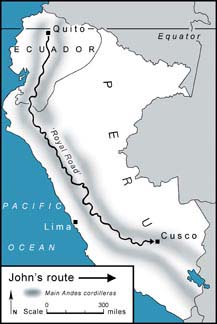
![]() Royal Road intro – First update – Previous update – Next update – Final update – Come to a talk!
Royal Road intro – First update – Previous update – Next update – Final update – Come to a talk!
Between Huancayo and Ayacucho the Royal Road is arguably at its most spectacular, climbing to 13,000 feet and then plunging more than 6,000 feet into a vast badland – soaring towers and seemingly bottomless gulches lined with some of the world’s sharpest cacti. The Inca roadbuilders obviously had some difficulty finding a route through this, and they managed quite well until about two-thirds of the way down when they seemed to give up and let the road go straight over the edge. I followed – well I wasn’t going to climb back up again – and slithered into one of the mini-canyons, only to find no sign of the road continuing down and absolutely no way up again.
I was now at about 9,000 feet; it was very hot indeed and I was using up my water at an alarming rate. So I pushed on downwards as best I could, occasionally finding a faint path, only to see it disappear again in an enormous copse of cacti, thorn bushes or other prickly things. Funnily enough I was quite enjoying myself, and the views to the river hundreds of feet below were awe-inspiring. Every so often I’d be brought up short by a huge spider’s web strung between the plants, occupied by a large and alarmed-looking spider. I photographed one of these from a comfortable distance, silently thanking my telephoto lens.
Now it was getting dark; my water was down to less than half a litre, and I was ripping myself to pieces without making much progress. So I took a risk and dropped right down into a deeply incised dried-up creek which descended in zigzags to the main river. Its walls seemed to have been sculpted by flash floods; but luckily in June there was no danger of these, so I made my way down the streambed, clambering over boulders and crawling under overhanging thorn trees. The canyon gradually broadened out; then to my dismay suddenly narrowed again to a notch where the waters must have tumbled over a waterfall. For a moment this looked like the end of my descent. The walls were vertical, so no escape there; and it was nearly dark. I decided there was nothing for it but to go over. Before I could change my mind, I hurled the rucksack over the edge and then slithered out of control down the rock face behind it. As I leaped the last ten feet I thought – what if there’s another bigger waterfall below? That would have been the end of the journey and possibly of me. But there wasn’t, and in the very last light I came out onto the wide river floodplain and on its edge found an irrigation channel with fresh clean water tinkling along it. It was a moment of delirious relief; I put up the tent on the sandy riverbed and did a little dance under the full moon.
But the valley hadn’t finished with me yet; as I cooked supper a swarm of voracious midges descended on my tent. In all my years’ exploring I’ve never seen the like of them – even in Scotland. Several hundred perished in my candle flame, but not before delivering a welter of excruciating bites on various exposed bits of flesh.
This first taste of the Andean gorges has
provided some useful lessons because an even deeper one awaits
me on the road to Cusco. This is the canyon of the mighty Apurímac
– ‘Great Speaker’ in Quechua –
a river regarded in horror by generations of travellers and which
nearly stopped the Spanish conquistadores in their tracks.
I’ll see shortly why.
